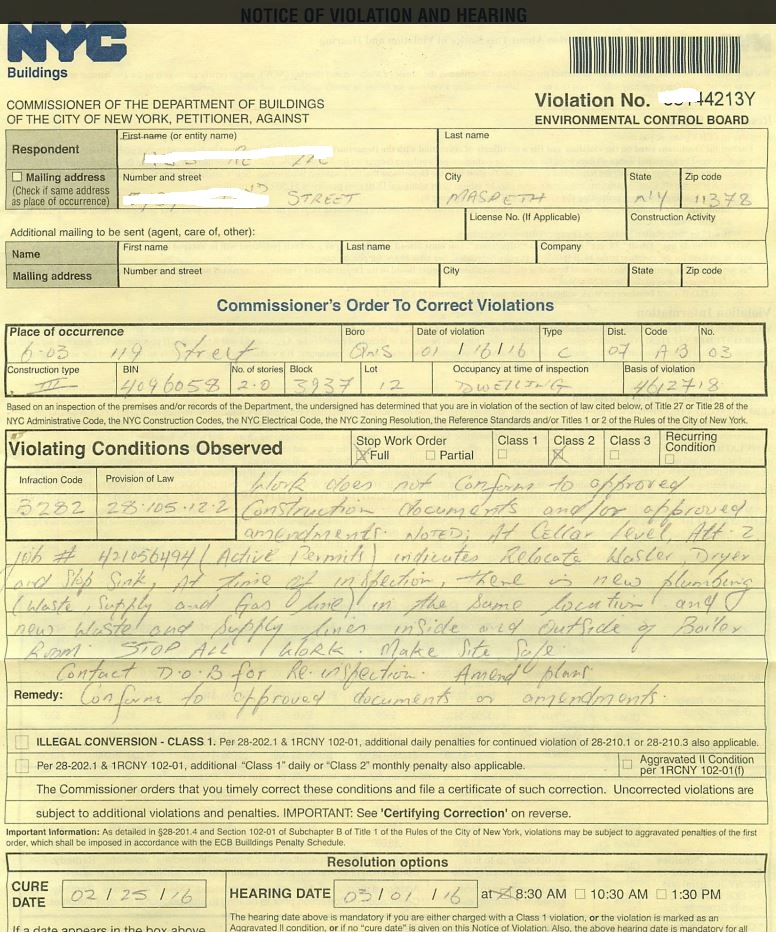Illegally altered buildings and apartments violate the City’s construction codes and can pose serious risks to tenants, neighbors and first responders in the event of a fire or other emergency. Unauthorized work is subject to violations and Stop Work Orders from the Department.
Violating New York City’s Construction Codes and Zoning Resolution puts people at risk and undermines our quality of life. The Padlock Unit enforces the City’s Administrative Code and Zoning Resolution to protect our quality of life and prevent dangerous conditions
Illegal Residences & Violations
An illegal conversion is any new living space built in an existing building without prior Department approval. Examples include bedrooms in a cellar or unauthorized rooming units called Single Room Occupancies (SROs). Unapproved construction can create serious danger: Adding a wall may keep people from escaping a fire and improper plumbing can lead to a gas explosion.
Department inspectors may issue Environmental Control Board (ECB) violations, which carry mandatory penalties. Property owners who do not attend their ECB hearing also face default penalties as high as $25,000 for each violation.
Correcting Illegal Conversion Violations
- Determine if the illegal construction can be legalized or must be removed. If you must re-construct, have all residents move.
- Have a registered architect or licensed professional engineer file plans and receive Department approval. Approval and/or permits from the Landmarks Preservation Commission.
- Pay the filing fees; have all necessary permits.
- Have licensed contractors perform the work following the approved plans.
- Obtain final Department signoff.
- Legalize the housing by securing a new Certificate of Occupancy.
- Submit a Certificate of Correction (and proof that the violations were corrected) to the Administrative Enforcement Unit.
Illegal Property Use
The Padlock Unit stops illegal manufacturing and commercial uses in residential neighborhoods and certain commercial districts. The property owner and business occupants may show their use is legal or move the business to a legal location. Otherwise, the unit will take action at the Office of Administrative Trials and Hearings (OATH) . If the judge rules for the Department, we’ll issue an Order of Closure, post Closure Notices and padlock the premises. It’s illegal to remove a posted Order of Closure.
Accessing a Padlocked Property
Anyone illegally entering a padlocked property can face criminal charges. The Department grants access to owners, occupants or others to correct the conditions. To request access, submit a completed and notarized Request for Access to Premises (PE7) form to the Padlock Unit.
Lifting an Order of Closure
To have an Order of Closure rescinded, remove the illegal business. The owner, mortgagee or person having an interest must download the Rescission of Order of Closure (PE5A) form from nyc.gov/buildings and submit a completed and notarized form to the Padlock Unit. The Department will lift the Order once the property passes an inspection.
Legally Operating a Home Business
Operating a business from home may be legal. Generally, your home occupation (defined by Zoning Resolution §12-10) can’t occupy more than 25% of the residence – up to 500 square feet – and no employees may work on-site. In limited areas, joint living-work arrangements – sometimes called “live/work” – are legal. Read the Zoning Resolution, available at the Department of City Planning’s website.

